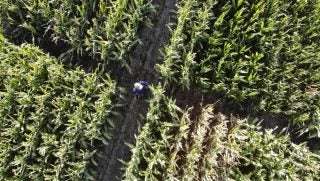I’ve lived in four states on the East Coast and Gulf, and I’ve never found myself wanting come harvest time. From vegetables on the family homestead in New York, to a year-round smorgasbord in Florida, to sugarcane in Cajun country Louisiana, to crops tucked between majestic mountains in Virginia — I’m consistently awed at what this season has to offer.
I can’t help but speculate about the harvest’s backstory — a “Behind the Music”-styled crop-umentary. What drama unfolded? Family squabbles? Pest/disease issues? Challenging customers or vendors?
I connect it to memorable experiences as a teenager: the zen-like hours spent on a manure spreader, hulking boxed lettuce out of a soaked field by hand, a bleary-eyed 6 a.m. tow thanks to a conked-out alternator, on-farm trials with Cooperative Extension, and informal mentoring by my grandfather.
Whatever the location or backstory, one thing is certain: Untold hours of expertise (and trial and error experimentation) have allowed farmer Joe/Jane to hone their craft. Hardship and conflict — but also success and boastful pride — is embedded in every grain of corn or head of lettuce. That’s a value added story that you can’t put a dollar figure on.
And then someone has to ruin the (still budding) nostalgia and say X is just a “factory farm.”
Sigh.
What does that imply? Based on campaigns I’ve seen, it suggests a boardroom mentality, accentuated by ecological permissiveness and profiteering. All orchestrated by scheming corporations that oversee “mega-farms” (whatever that is). Productivity is paramount, to the detriment of everything and everyone else. Tank the environment long-term for short-term profits. We report to the shareholders. Take the money and run!
Maybe this sums up the stereotype. It’s no doubt been carefully fashioned and brain-dumped in our social fabric — so pervasively that it’s regularly used to defame ag. But in reality, it’s a term with no defined boundaries. And it automatically judges farmers guilty of some mystery crime without any due process or reason. All for being too big? Too technically inclined? For being too profitable? For not following dated, idyllic notions of what a farm should be like?
Thinking about all of the steps leading to harvest, here are some common factors to consider — and why “factory farm” is one of the most disingenuous phrases in the playbook.
Mechanization and Technology: Most farms use technology to streamline their operations, from preparation to seeding to harvest. I’ve seen 30 row corn seeders equipped with auto-steer GPS, in a climate controlled cab, with an mp3 player. Should this automatically qualify as factory-inspired and justify those nice oversized “FF” scarlet letters? Proudly accessorize with vinyl decals on that cab. Would you prefer planting or harvesting row by row, humming to yourself, while being exposed to unforgiving elements?
Inputs: Pests and diseases are always eyeballing their next meal ticket. Even with the use of integrated pest management (IPM — a sensible, multi-tool approach to tackle critters), pesticides are still a necessity. Anyone who thinks otherwise is disconnected from the day-to-day realities of farming. Success in a pesticide-free garden does not scale to a 1-acre or a 1,000-acre field. And the judicious use of fertilizer has been a godsend to productivity. Plants like to be coddled. Most of the public is unaware that soybeans and the like make their own fertilizer, leaving some behind for the next crop (like corn).
GMOs: An unqualified success if you can get them (regrettably there’s no such thing as GMO greens or herbs for my family’s farm). Definitely corporate supplied, but is it much different from procuring supplies from a local cooperative? And organic fertilizer and pesticides are just as corporate as any other (unless we’re going to impose a market cap cutoff for doing business with entities that are “too” corporate to stomach).
Productivity: A composite of the above. Bushels/acre, boxes/acre, whatever the units. Can efficiency be so readily dismissed? Can it be reconciled with stewardship?
Stewardship: Exhaustive nutrient management plans — including erosion mitigation and mass plantings of native species in riparian zones to catch and process excess runoff — are not unusual. If measured on a pollution generated per unit area (point and non-point source), how much of a difference would there be between a quaint small farm vs. a “corporate” farm? Barring the most egregious bad actors (they certainly exist!) is one flavor apt to be a better steward than another?
Size/Acreage: What’s the cutoff? Is this like breaching an enchanted dividing line between heaven and hell, maybe straddling purgatory for those on the fence?
Ownership: The vast majority of farms are family run and owned, not a front for some faceless corporate entity. Many farms are definitely incorporated (my family farm is an LLC) — a legal construct to draw a clear line of demarcation between liability in the personal and business realms.
Worker Standards: Eschewing technology means backbreaking manual labor. Not exactly celebrating the legacy of Caesar Chavez and other farmworker advocates. What are farms paying their workers (if they can find them, and if they’re even necessary at all due to mechanization)? Are consumers willing to pay more to indirectly pay laborers more?
Profitability: Can one bank too much, going from friendly neighborhood farm to onerous corporate one? Given the premium they command at the cash register, organic operations should be able to spread the wealth and pay their field laborers (doing the backbreaking labor) more. It’s social justice after all. But wait, they generally have shareholders to appease, too.
I’m not going to artificially cap my farm size, time plantings on phases of the moon, or plant a cow horn filled with fermented dung for a bountiful harvest (see biodynamics for that bit of real-world absurdity). Unless you’re a celebrity in it for the bragging rights — and have the luxury of hemorrhaging dough — farmers have an economic interest in turning a profit. This includes using pesticides and fertilizers (both an upgrade from karma and superstition), and upgraded machinery from the ox and plow.
During this bountiful harvest season, don’t let divisive, phony phrases like “factory farm” sully your perceptions of honest farmers on the job.
Tim Durham’s family operates Deer Run Farm — a truck (vegetable) farm on Long Island, New York. As a columnist and agvocate, he counters heated rhetoric with sensible facts. Tim has a degree in plant medicine and is an Assistant Professor at Ferrum College in Virginia.



